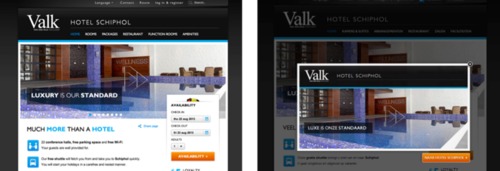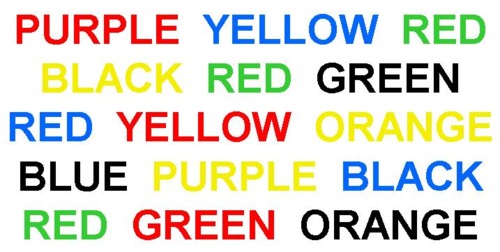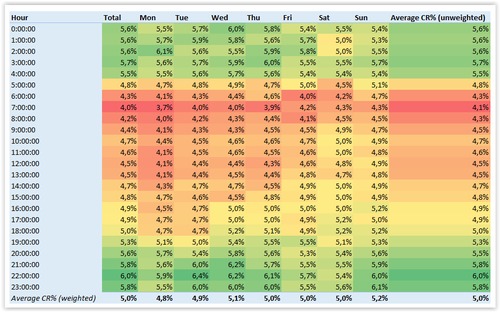“The unpleasant truth: we’re not or barely conscious of what determines our perceptions, memories, thoughts, emotions, decisions, and even behavior.”
You, as someone working in marketing, are helping to create, communicate, deliver, and exchange products and/or services that have a value for customers.
But customers are brains… The processes that take place in their 3 pounds of cortical proteins and fats ultimately determine their purchasing behavior. Hence, this ‘short intro’ to the psychology behind CRO.
First, an A/B test case. Which variant causes 12% more people to book a Van der Valk hotel room?

Most people say they prefer the variation without the annoying popup, but the conversion rate is higher with the popup. How can a decrease in usability lead to more sales?
Customers Are a “Dual Processing Brain”
Although psychologists (and psychographics) have been studying this for over 50 years, it is mainly thanks to Daniel Kahneman – a leading psychologist, the spiritual father of behavioral economics and winner of the Nobel Prize – that people are realizing that our brain is home to 2 systems:

- System 1 is the oldest system (600 million years). It works on the basis of intuition, emotions, habits, prejudices and “heuristics”. It functions outside of consciousness, completely automatically and processes enormous amounts of information with seemingly little or no effort. All without the feeling of voluntary control.
- System 2 is a relatively new system (it became really apparent only 70 thousand years ago during ‘the cognitive revolution’). It is a conscious, rational, systematic and logical system. It uses scarce mental energy to control the impulses of System 1.
An easy way to experience both systems yourself is the Stroop Test. Read out loud the color of the words displayed below. You’ll probably find yourself (System 2) struggling to fight the automated (System 1) response, which is to read out the word instead of its color.

System 2: Conscious, But Usually Absent or Quickly Depleted
Our System 2 has certain prominent characteristics. Since this is just an introduction, I’ll stick to three.
1. Usually absent
First of all, it’s good to realize that our conscious System 2 is absent when we make most of our decisions (though we have the illusion that we are in control).
An example: “I have two kids, one is a boy. What is the chance that the other is a boy too”? Most people answer 50%. But that’s not the logical answer. System 1 answered an easier, automated question (“What’s the general chance of having a boy or girl?”) and System 2 was absent.
2. Lying
Our consciousness (System 2) is “post-decision rationalizing” all the time. If it was not involved (absent or depleted), it will make up “rational reasons” after the decision was made purely subconsciously.
3. Limited capacity
System 2 has a “very, very limited capacity”. For example, one group is asked to remember the number 39 and another group to remember 3,852,869. While remembering the numbers, they’re asked to choose a reward: chocolate cake or fruit salad. The “39” group chose chocolate cake only 41% of the time. Even though System 1 craves the cake, they have enough System 2 capacity left to control their impulses. In the other ‘3,852,869’ group, less System 2 capacity is left, and a staggering 61% opts for the chocolate cake.
Ego-Depletion: Indicator of System 2
One of the results of our limited mental capacity is that our System 2 depletes during the day. We make more rationally controlled decisions in the morning, and more emotional ones at the end of the day.
Therefore, it helps to plot your conversion rates based on the hours of the day and week. If you find a graph like the one below, you likely operate in a System 1-driven market (since lower impulse control leads to higher conversion rates).

System 1: The Always Awake, Multi-Tasking System
So most of our decisions are made by our subconscious and all of them are influenced by it. This automated system is:
- always on,
- makes decisions on the fly,
- is based on an associative neural network,
- processes information extremely quickly, and
- judging –almost always correctly– in a fraction of a second.
Our automatic System 1 is therefore the true superhero in our brain. But one email is too short to explain anything more about the hundreds and hundreds of biases, emotions and heuristics it operates on. Please read my blog for some techniques.
How to Persuade a Dual Processing Brain
An example where System 1 totally determines the decision and System 2 should not get involved is this flash deal site. We deleted CTAs and made prices less apparent to keep System 2 asleep. Moreover, we made System 1 a bigger fan by adding large images and heart symbols.

Yet sometimes it is totally the other way around. For example, when opening a savings account. We need System 2 to take and stay in control in this case, since System 1 would love to spend the money on more instantly rewarding things (like one of those flash deals).
In the example below, we took away the (distracting and depleting) navigation. Most importantly, we put the full focus on only one of the interest rates (preventing System 2 from doing the depleting calculation).

Now think back to the Van der Valk hotel case. Although our System 2 dislikes the energy-costing popup, our System 1 experiences something different.
It sees a first click, and automatically draws the conclusion that you like this site better than others (that you did not click). It will remain consistent with opinion, and is thus more likely to book a room after the user-unfriendly popup.

Customer-Centric? Dual Process-Centric!
So, psychology teaches us that consumer behavior and user experience are extremely complex (fortunately). At the core, there are 2 systems that determine behavior and experiences. You can use this knowledge about psychology to make true sense of your CRO efforts, and make them more effective.
Takeaways
- Try to map which system is in control on each page of your site and in each visitor segment by re-analyzing your data and test results.
- For System 2, focus on one thing. Offer post-decision alibis, make it effortless.
- For System 1, start learning more about the hundreds and hundreds of persuasive biases and heuristics to make the most emotionally delightful experience possible.
For more from Bart, check out Online Dialogue and Wheel of Persuasion.
Read Next Lesson or Download guide as PDF
-
Introduction to Conversion Optimization by Brian Massey
Copywriting, A/B testing, analytics, psychology... we'll cover it all. But first, Brian Massey, the Conversion Scientist, reminds you of the basics. -
How to Write Copy That Sells Like a Mofo by Joanna Wiebe
Joanna Wiebe of Copy Hackers and Airstory on how to write copy that converts like crazy. -
Introduction to Designing for Conversions by David Kadavy
David Kadavy, author of Design for Hackers, on designing for conversions. He debunks today's biggest design myths and tells you what actually matters. -
How to Use Psychology in Conversion Optimization by Bart Schutz
Bart Schutz of Online Dialogue and The Wheel of Persuasion on using psychology to increase conversions. -
Emotional Targeting 101 by Talia Wolf
Talia Wolf of Conversioner talking emotional persuasion. Building on what we learned from Bart, she explains how to appeal to your visitors' emotions. -
How to Build a List and Send Emails That Convert by Justine Jordan
Justine Jordan from Litmus walks you through collecting emails, improving your open rate, designing for all browsers / devices / email clients, A/B testing emails and more. -
How to Setup Analytics and Measure the Right Stuff by Chris Mercer
Chris Mercer from SeriouslySimpleMarketing.com on how to setup your analytics in a meaningful way that ensures you're gathering useful data. -
How to Use Analytics to Find Insights by Yehoshua Coren
Yehoshua Coren, the Analytics Ninja, walks you through extracting insights from your analytics using segmentation. -
How to Gather Qualitative Data for Insights by Jen Havice
Jen Havice of Make Mention on how to use qualitative research to answer one of the most important questions in conversion optimization: Why? -
What to Test (Conversion Research) by Michael Aagaard
Michael Aagaard, senior conversion optimizer at Unbounce, on how to strategically decide what to test using conversion research. -
How to Run A/B Tests by Peep Laja
Peep Laja teaches you everything you need to know to run valuable, statistically valid tests that will actually lead to applicable insights. -
How to Create a CRO Process by Peep Laja
Peep on how to combine everything you've learned into a systematic, repeatable CRO process.